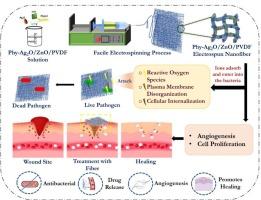负载叶绿醇和金属氧化物的静电纺聚偏氟乙烯纳米纤维用于感染控制和再生伤口愈合
IF 5.1
3区 工程技术
Q1 CHEMISTRY, APPLIED
引用次数: 0
摘要
肠道系统的细菌感染仍然是一个主要的健康问题,碳青霉烯耐药病原体对伤口管理构成了重大挑战。传统的治疗方法往往不能结合感染控制和组织再生,强调需要先进的多功能敷料。本研究以聚偏二氟乙烯为聚合物底物,负载天然生物活性化合物叶绿醇,以氧化银和氧化锌纳米颗粒为纳米填料,制备了电纺丝纳米纤维。这种新型组合物被设计用于对抗耐药感染和促进伤口愈合。采用傅里叶变换红外光谱、x射线衍射、扫描电镜、能量色散x射线光谱、热重分析和差示扫描量热法对纳米纤维进行了表征。理化分析证实其有效成分分布均匀,具有良好的特性,包括溶胀性、柔韧性、孔隙性、药物释放性和可控降解。体外生物学研究显示其具有较强的抗菌活性,良好的血液相容性,对HaCaT细胞无细胞毒性。重要的是,纳米纤维在绒毛膜尿囊膜实验中显示出血管生成的潜力,在伤口划伤实验中增强了细胞的粘附、迁移和增殖。总之,叶绿醇与金属氧化物纳米填料在PVDF基质中的集成代表了设计下一代伤口敷料的新方法。所开发的电纺丝纳米纤维在加速组织再生的同时,解决了控制多药耐药感染的迫切临床需求,显示出巨大的潜力。本文章由计算机程序翻译,如有差异,请以英文原文为准。

Phytol and metal oxide-loaded electrospun polyvinylidene fluoride nanofibers for infection control and regenerative wound healing
Bacterial infections of the integumentary system remain a major health concern, with carbapenem-resistant pathogens creating critical challenges in wound management. Conventional therapies often fail to combine infection control with tissue regeneration, emphasizing the need for advanced multifunctional dressings. In this study, we developed electrospun nanofibers were fabricated using polyvinylidene difluoride as polymer substrate loaded with phytol as a natural bioactive compound, and a combination of silver oxide and zinc oxide nanoparticles as nanofiller ingredients. This novel composition was designed to combat drug resistant infection and promoting wound healing. The nanofibers were characterized by Fourier-transform infrared spectroscopy, X-ray diffraction, scanning electron microscopy, energy-dispersive X-ray spectroscopy, thermogravimetric analysis, and differential scanning calorimetry techniques. Physicochemical analyses confirmed uniform distribution of active components and favourable properties including swelling, flexibility, porosity, drug release properties and controlled degradation. In vitro biological studies revealed strong antibacterial activity, excellent hemocompatibility, and non-cytotoxicity toward HaCaT cells. Importantly, the nanofibers exhibited angiogenic potential in the chorioallantoic membrane assay and enhanced cell adhesion, migration, and proliferation in wound scratch experiments. Overall, the integration of phytol with metal oxide nanofillers in a PVDF matrix represents a novel approach to designing next-generation wound dressings. The developed electrospun nanofibers showed significant potential for accelerating tissue regeneration while addressing the urgent clinical need to control multidrug-resistant infections.
求助全文
通过发布文献求助,成功后即可免费获取论文全文。
去求助
来源期刊

Reactive & Functional Polymers
工程技术-高分子科学
CiteScore
8.90
自引率
5.90%
发文量
259
审稿时长
27 days
期刊介绍:
Reactive & Functional Polymers provides a forum to disseminate original ideas, concepts and developments in the science and technology of polymers with functional groups, which impart specific chemical reactivity or physical, chemical, structural, biological, and pharmacological functionality. The scope covers organic polymers, acting for instance as reagents, catalysts, templates, ion-exchangers, selective sorbents, chelating or antimicrobial agents, drug carriers, sensors, membranes, and hydrogels. This also includes reactive cross-linkable prepolymers and high-performance thermosetting polymers, natural or degradable polymers, conducting polymers, and porous polymers.
Original research articles must contain thorough molecular and material characterization data on synthesis of the above polymers in combination with their applications. Applications include but are not limited to catalysis, water or effluent treatment, separations and recovery, electronics and information storage, energy conversion, encapsulation, or adhesion.
 求助内容:
求助内容: 应助结果提醒方式:
应助结果提醒方式:


